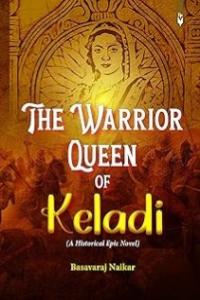Creation and Criticism
ISSN: 2455-9687
(A Quarterly International Peer-reviewed Refereed e-Journal
Devoted to English Language and Literature)
Vol. 09, Joint Issue 32 & 33: Jan-April 2024

Critique
A Tribute to
the Lost Glory of the Puissant Queen of Keladi
Sabita Tripathy
Received on Feb 15, 2024; Accepted on March 20, 2024. Available online: April 10, 2024. This work is licensed under a Creative Commons Attribution-NonCommercial 4.0 International License
The Warrior Queen of Keladi by Professor Basavaraj Naikar is an awe inspiring historical novel. In our country many a historical facts are not properly documented; significant historical achievements of people of India are lost in oblivion. Thanks to Professor Naikar’s efforts that he has engaged his valuable time in the retrieval of some of the historical treasures that lie hidden and thus, neglected. History becomes interesting and educative only when it is documented for people to glean and peruse. This novel proves what Hayden White says about history: history becomes interesting only when it becomes a story. Converting a piece of history into a convincing and enjoyable and authentic story is not a joke but requires a lot of research, data collection and historical imagination to synthesize all them into a coherent whole. Dr. Naikar has done his job with great success in this novel.
Naikar’s portrayal of Queen Chennamma of Keladi in the Kingdom of Karnataka shows women’s empowerment in India in the 17th century as a warrior woman who could prove herself as an able administrator and benevolent queen. Professor Naikar’s close attachment to the kingdom adds emotional and psychological impact and makes the subject more appealing and lively. After the fall of Keladi kingdom in the latter part of 18th century when Hyderali defeated Rani Virammaji, she migrated to north Karnataka and took shelter in the kingdom of Naragund.
As revealed by the author of the book, the forefathers of Naikar were well attached to the royal family; hence the narration of events bears truth and authenticity. The paternal great grand-uncle of the author Sri Virabhadra Nayaka served as Dandanayaka in the Naragund kingdom and lost his life while defending his country to the invincible army of East India Company. The kingdom of Keladi was under the control of Vijayanagara Empire. The Chief of Keladi, Chowdappa Nayaka, was naturally loyal to the ruler of Vijayanagara. After the dismantling of Vijayanagara Empire, Keladi became an independent state nearly in 1500 A.D. The first kingship was offered to Chowdappa Nayaka. He constructed a beautiful temple of Rameswara and established a Linga to sanctify the temple. The Royal families of Keladi got many Virasaiva monasteries. Goddess Mukambika of Kolluru, Goddess Sarada of Sringeri and many more have magnificent temples attached to them and received offerings in cash, gold, and jewelleries, etc.
After Chowdappa Nayaka’s death, Sadasiva Nayaka made Ikkeri his capital. He opened many theatre houses and took interest in extending the boundary of his empire. Raja Sivappa Nayaka had five queens. Somasekhara Nayaka, the son of his fifth queen was a heroic boy with undaunted courage and bravery to his credit; all considered him as the worthy heir to the throne. Raja Sivappa Nayaka built a strong and invincible fort nearest to Honnavara and equipped it with fatal armour. He built watch towers and supplied them with ammunitions. He named his fort after Basaveswara as “Basavaraja Durga”. Childless couples flocked the temple to worship the deity and observe fasting with a desire to be blessed with child. Siddappasetti, a merchant’s wife was blessed by following the rituals. Paying due respect to the god’s name and fame, the couple named their daughter Chennambika. The parents considered their daughter as a blessing of God, so they trained their daughter as a son. Indeed, Chenna was a versatile genius. HH Her father trained her in all domestic chores and many feminine qualities. She became a perfect horse rider and a clever business woman. She learned Sanskrit, Kannada, hymns and mantras.
When Raja Sivappa Nayaka revisited Kotepura, Prince Somasekhara Nayaka fell in love with Chenna. After marriage the newly-wed couple went round the kingdom. Prince Somasekhara Nayaka introduced Chenna to different political parties, royal places as well as forts. He also brought much secrecy of royal families to Chenna’s notice. He revealed the enmity of the king of Mysore, Maharastra and how they are trying to sneak the borderline. Keladi is a city of their forefathers and they are supposed to protect Keladi from the clutches of the enemies. They also visited the temple of Rameswara and invoked God’s blessings. Prince Somasekhara narrated to Chenna the story behind the construction of the temple. He narrated how his forefathers used the water falls for irrigation of lands and constructed reservoirs, lakes to meet future challenges of water scarcity in summer seasons. They had made the land fertile for cultivation of pepper, cardamom, cloves, rice coconuts, etc to improve merchandise trade with other countries. They sold rice to Arab countries and bought horses of high breed.They visited many temples like Lord Virabhadra, Goddess Parvati, monasteries, beautiful Sahyadri Mountain range and Arabian Sea. Rani Chennamma was thrilled by the enchanting heavenly beauty on this earth.
Ikkeri is another place for heroism and adventure. They paid their tribute to Aghoreswara and planted trees there. The statue of elephants, Nandi were so artistically carved to attract visitors to the rich sculpture of Keladi. The author Naikar through the travelogue of Chennamma along with the prince has brought the legend of Dodda Shankanna Nayaka, Prabhu, The Maharaja of Sivamogge’s administrator, Sabanisa Heggade and other important persons of the city. During their tour to the various parts of Keladi, the Prince and Chennamma discussed problems with the common peasants, warriors, businessmen, artists and their problems with smile on their faces. They trained their soldiers to be brave and prepared themselves to meet any attack. They also worshipped the elements of the earth and prayed them for the happiness of the citizens.
In order to create public awareness programme, both the king and the Queen mixed with the public by singing and chanting slokas to appease Gods and Goddesses for the welfare of their motherland.
Keladi and Ikkeri had aesthetic and artistic beauty. The credits for these artistic renderings go to the king, the father of Somasekhar who paid special attention to these monumental constructions. The city of Sivamogge is a place of historical significance. It was ruled by the kings of Ganga, Kadamba, Chalukya and Vijayanagara dynasties. The royal couple after visiting the monastery of Anandapura received by the Swamiji of Bekkina Kalmatha Monastery and performed the rituals. Rani Chennamma was astounded by the beauty of the deep forest and tall mountains with fresh water from the rivers. The Prince related every significant historical event to Chennamma. The grandfathers of the Prince defeated Cheluma Rangappa and captured the fort. This fort had impregnable walls. The Prince directed Dalapati to provide extra weapons to the armoury of Sivamogge, Ikkeri and Keladi to strengthen the army. The rich heritage of the palace Bhuvanagiri, - Durga and royal court were built with china plates; the stone platforms were carved by superb artists and sculptural pieces like Sadasivanagara and Soraba. Jubilant celebrations such as Vasantotsava, Dasara festival are observed by worshipping the family deity Mukambika. Many artists participated in the celebrations of Ugadi day.
The author has vividly narrated the incidents of the different villages of Kashmir and Keladi where the royal couple, soldiers Dalapati and his family, Mukhia of the gram panchayats (village councils) spend intimate and secret moments together. This shows the common bond of love between the queen and the people. The ruler and the ruled relationship is based on food, costumes, royal offerings to the Goddesses of the village. Equality, fraternity feelings and gratitude to their Kuladevata are very rare these days. The Prince, the Queen came down to the level of the common people of the country to build cohesion and integration. This great tradition of India has been encapsulated in the book The Warrior Queen of Keladi by Basavaraj Naikar in order to immortalise the past history of India.
The royal couple got enough time during their honeymoon tour to understand each other. Prince Somesekhara Nayaka and the Queen presented themselves to their parents a full knowledge of the country not to be cheated by any one in future.
The War between Bidanuru and Bilagi and Swadi started with heavy casualties. Prince Somesekhara Nayaka captured the king of Swadi and Bhadrappa Nayaka captured the king of Bilagi and brought many prisoners. On receiving secret information that the Mysuru kings were about to invade Keladi, Maharaja Sivappa Nayaka assumed the role of the Commander of the entire army. The king became terribly sick and breathed his last peacefully. Two Ranis became voluntarily Mahasatis. The army of Mysuru scattered due to strong attack of Maharaja Venkatappa Nayaka Sivalingayya had killed the old maharaja. Then Prince Somesekhara became happy with the coronation of his older brother Bhadrappa Nayaka. Bhadrappa went on a pilgrimage by handing over the charge of his kingdom to Somesekhara.
The author has made a well blending of the theme of patriotism and war in the story. Sultan Adilshah of Bijapur’s enemity with the king of Keladi and repeated defeat followed by conspiracy and disguise are reported skilfully in the book. To get a successor to the throne of Keladi Maharaja drank the medicine cunningly given by Bharama, his elephant trainer. The medicine worked as poison on his body. This was a secret conspiracy hatched by Jinnopant. Rani Sarkar’s meticulous care, rigorous application of medicine on the body helped Maharaja to recover from the medicinal effect quickly. It was known that Jnnopant was planning to usurp the kingdom of Keladi and annex it to the Bijapur kingdom and acquire a large property in terms of gold, jewels by the grace of Sultan Adilshah. Maharani Chennamma became terribly grief-stricken when she found Maharaja bleeding. She packed up the sword and went to the battle field. She taught a good lesson to the army of Adilshah.
The Maharaja advised the Rani to rule the kingdom instead of becoming a “sati” in the funeral pyre of the Maharaja. The Rani, on the other hand, with the knowledge of martial arts and the art of political administration prepared her mind to preserve the security and safety of her country. The followers of the crooked minded Sivappa Nayaka entered the palace and celebrated the death of the king as the Maharani refused to adopt the boy suggested by Sivappa Nayaka. Some Dalapatis of Sivappa Nayaka emerged as the trouble shooters. Anarchy was just about to set in every part of the kingdom. The Rani took over the administration of the country for the benefit of the subjects. The Swamiji of Hirematha Monastery of Keladi chanted mantras and solemnised the enthronement of the Rani in 1672 A.D. He renamed the ten year boy Basavappa Nayaka and Chennamma adopted him as her son. The biological parents announced this publicly.
Maharani Chennamma addressed the soldiers as brothers and protectors of Keladi and requested tem to guard the kingdom from innumerable enemies. She distributed new clothes, gold coins, food, and lands to all the soldiers. By the grace of Goddess Mukambika, Rani ruled over the country with her adopted son. She signed fresh agreements of trade and commerce with foreign merchants. She made merchandise deals with the Dutch and Portuguese merchants.
Maharani Chennamma gave military salute to her soldiers and addressed them cordially as “My dear soldiers, brothers, you are the supporting pillars of our kingdom. In fact, you are the real treasures of our kingdom.... you should never betray your kingdom because of your greed. She expanded the foreign trade and commerce at Mangaluru so much that the public felicitated the Queen. She very cleverly captured Rangamma’s mal- administration so far as the tax collection documents of the foreign merchants are concerned. The people of Kasaragodu offered a sword to the Rani and said, “Dear Rani Sarkar, we are offering you this sword so that you may destroy the evil people in this kingdom.”
The feudatory chief of Hulikere fort continued his immoral administration and led a libertine life. He arrogantly commented, “Why should I be a vassal to the king of a kingdom which is ruled by a mere woman?” Maharani Chennamma wanted to teach him a lesson. Prince Basavappa Nayaka was also interested to join his mother but his age obstructed him.
A horrible war took place between Keladi and Hulikere and the leader was killed. By travelling far and wide, the Rani brought a lot of transformations for the benefit of the subjects. She changed the beliefs, superstitions, living habits of the people. She stopped people from earning their lives by begging. She taught people to do hard work. Amidst her busy schedule, she gave the best education to the prince by Mari-Tontadarya. Then Basavappa Nayaka occupied the throne of Keladi when he reached his proper age. He got married to Chandramma and Basavalingamma of a royal family. Emperor Aurangazeb’s eyes fell on Keladi and the Moghul army attacked the kingdom in 1690. The battle continued nearly for three months. Aurangazeb got tired of fighting in the inimical circumstances. He was forced to sign a peace treaty with the Maharani at Bidanuru. The Maharani can be aptly described as an incarnation of Mahisasura Mardini for the enemies. The Maharani had rightly understood that there were no companions in pursuit of one’s spiritual salvation and that God is the only true companion in the last days of one’s life. She very often followed her sadhana and meditation in caves alone. She came to know that after the death of Aurangazeb his sons have become engaged in the encroachment of each other’s land and territory. The Rani became very sick. She advised all to perform the last Sravan Monday linga puja. On the last day she paid a tribute to all gurus, gods and goddesses. People narrate the story of her generosity. It became very difficult for soldiers and other beneficiaries to control their tears. Twenty five cannons were fired in honour of the Warrior Queen Chennamma. Her teachings and inspirational words still encourage the people of Keladi.
Likewise, he has depicted the female heroism of the queen, her religious tolerance, her respect for parents and parents-in-law, her reverence for the holy men of Virasaiva religion, her affection for the soldiers of her kingdom and her extraordinary courage of conviction in her giving shelter to Prince Rajaram of Kolhapur thereby earning the wrath of the cruel Emperor Aurangzeb very elaborately and convincingly. The court intrigues and counter- intrigues, changing loyalties and betrayals, maintenance of territorial integrity, espionage and counter-espionage, clever war strategies, rites and rituals and polygamies along with monogamies create a deep impression on the modern reader with their rich texture of historical tapestry (a la Walter Scott novel about British history). Similarly, the geographical details of scenic beauty, the flora and fauna of the middle part of Karnataka, especially of the Sahyadri Mountain range of the medieval times add to the beauty of the novel. The novelist has suggested the fleeting march of Time behind the various activities and events of history and shown the inexorability of human Fate.
Basavaraj Naikar has enriched the realm of the otherwise poor genre of Indian English historical fiction. He has recreated a neglected slice of Indian history and shows not merely the past-ness of the past but the relevance and the present-ness of the past to the modern readers. The reading of his novel gives us a rich experience of history which is at once enlightening and elevating. Rani Chennamma, the warrior queen, even while being part of the patriarchal feudal society of India, easily becomes a role model to the modern Indian women. This novel needs to be compared and contrasted with similar novels of other Indian novelists like, for example, The Last Queen (by Chitra Bannerji Divakaruni,) The Valiant Queen of Kashmir, Begum Sumroo and so on. It is high time for some adventurous researchers to undertake serious research on the historical novels of Indian English Literature.
Work Cited:
Naikar, Basavaraj, The Warrior Queen of Keladi. Emerald Publishers, 2022. Pages: 512. Price: Rs. 375/-. ISBN: 9789392188176
About the Author:
 Dr. Sabita Tripathy is a Professor in the P.G. Department of English at Sambalpur University, with over 33 years of teaching experience. She holds an M.A. in English, a B.Ed., and a Ph.D. with a research focus on Sri Aurobindo’s literature. Her academic specialization lies in Indian English Literature and Non-British Novels in English. A dedicated educator and scholar, Dr. Tripathy has significantly contributed to the study and teaching of postcolonial and Indian literary traditions. She is actively engaged in academic discourse and can be reached at sabitatripathy33@gmail.com for scholarly communication and collaboration.
Dr. Sabita Tripathy is a Professor in the P.G. Department of English at Sambalpur University, with over 33 years of teaching experience. She holds an M.A. in English, a B.Ed., and a Ph.D. with a research focus on Sri Aurobindo’s literature. Her academic specialization lies in Indian English Literature and Non-British Novels in English. A dedicated educator and scholar, Dr. Tripathy has significantly contributed to the study and teaching of postcolonial and Indian literary traditions. She is actively engaged in academic discourse and can be reached at sabitatripathy33@gmail.com for scholarly communication and collaboration.


